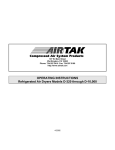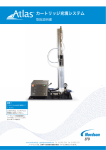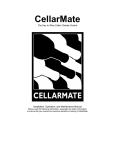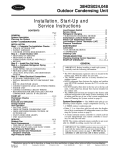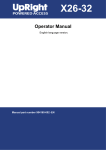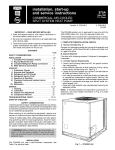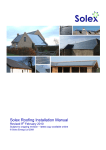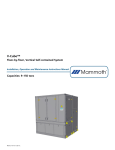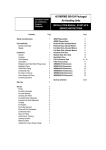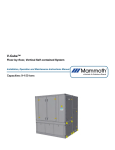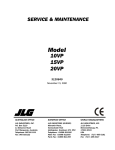Download Carrier 09BY006-024 User's Manual
Transcript
09BY006-024 Air-Cooled Condenser Units 5 to 20 Tons Installation, Start-Up and Service Instructions CONTENTS Page SAFETY CONSIDERATIONS . . . . . . . . . . . . . . . . . 1 GENERAL . . . . . . . . . . . . . . . . . . . . . . . . . . . . . . . . . . 1 INSTALLATION . . . . . . . . . . . . . . . . . . . . . . . . . . . . 1-12 Step 1 − Complete Pre-Installation Checks . . 1 Step 2 − Rig and Place Unit . . . . . . . . . . . . . . . . 7 • RIGGING • PLACING THE UNIT • VIBRATION ISOLATION • POSITIONING THE 09BY UNIT • VERTICAL DISCHARGE Step 3 − Install Accessory Low-Ambient Kit or Inlet Filter Kit (If Required) . . . . . . . . . . . . . . . . 8 Step 4 − Install Rain Drain . . . . . . . . . . . . . . . . . 8 Step 5 − Complete Refrigerant Piping . . . . . . . 8 • GENERAL • REFRIGERANT LINE SIZING • PRESSURE RELIEF • REFRIGERANT RECEIVER • LIQUID LIFT • SWEAT CONNECTIONS • FIELD PIPING • MANIFOLDING CIRCUITS • CHECK VALVE • SERVICE VALVES Step 6 − Ductwork . . . . . . . . . . . . . . . . . . . . . . . . 10 • CONDENSER AIR DUCT INSULATION Step 7 − Insulate the Unit . . . . . . . . . . . . . . . . . 11 Step 8 − Complete Electrical Connections . . 11 • GENERAL • MAIN POWER WIRING • CONTROL CIRCUIT POWER WIRING • GENERAL WIRING NOTES START-UP . . . . . . . . . . . . . . . . . . . . . . . . . . . . . . . . . 13 System Evacuation and Dehydration . . . . . . . . 13 Charging Procedure . . . . . . . . . . . . . . . . . . . . . . . 13 Check Operation of Condenser Fan Motor Controls and Rotation of Fans . . . . . . . . . . . 13 Adjust Fan Speed . . . . . . . . . . . . . . . . . . . . . . . . . 13 SERVICE . . . . . . . . . . . . . . . . . . . . . . . . . . . . . . . . . 13-15 Cleaning Condenser Coils . . . . . . . . . . . . . . . . . 13 Lubrication . . . . . . . . . . . . . . . . . . . . . . . . . . . . . . . . 13 Condenser Fan Adjustment . . . . . . . . . . . . . . . . 13 • TO CHANGE FAN SPEED • PULLEY ALIGNMENT • BELT TENSION ADJUSTMENT • TO CHANGE FAN WHEEL • TO REPLACE FAN BEARING MAINTENANCE . . . . . . . . . . . . . . . . . . . . . . . . . . . . 15 Cleaning . . . . . . . . . . . . . . . . . . . . . . . . . . . . . . . . . . 15 Inspection . . . . . . . . . . . . . . . . . . . . . . . . . . . . . . . . . 15 Air Filters . . . . . . . . . . . . . . . . . . . . . . . . . . . . . . . . . 15 Condensate Drain . . . . . . . . . . . . . . . . . . . . . . . . . 15 TROUBLESHOOTING . . . . . . . . . . . . . . . . . . . . . . 16 START-UP CHECKLIST . . . . . . . . . . . . . . . . CL-1,CL-2 SAFETY CONSIDERATIONS Installing, starting up, and servicing air-conditioning equipment can be hazardous due to system pressures, electrical components, and equipment location. Only trained, qualified installers and service mechanics should install, start-up, and service this 09BY equipment (Fig. 1). When working on the equipment, observe precautions in the literature and on tags, stickers, and labels attached to the equipment. Follow all safety codes. Wear safety glasses and work gloves. Keep quenching cloth and fire extinguisher nearby when brazing. Use care in handling, rigging, and setting bulky equipment. ELECTRIC SHOCK HAZARD Separate power sources (main and control power circuits) are used for these units. Be sure both main and control power circuits are disconnected before servicing. GENERAL The 09BY air-cooled condenser is a remote air-cooled condenser designed to be used with the 50BZ vertical packaged units. See Table 1. Airflow is horizontal, both into and out from the same face of the unit. The unit is designed to be mounted indoors in a window, through the wall in high-rise buildings, or on the wall on the building exterior. See Fig. 2 for typical applications. Ductwork is not needed, but may be added easily if required by the application. Airflow is provided by centrifugal fans with an adjustable belt drive to meet varying static requirements. Units may also be matched with other compressor and evaporator combinations. Contact your local representative for more details. Check space requirements, service clearances, floor strength, location of piping, size of power supply, and location of ductwork (if used) before installing. See Fig. 3 for unit dimensions and Table 2 for unit operating weights. INSTALLATION Step 1 — Complete Pre-Installation Checks — Examine unit for damage incurred during shipment. File claim immediately with transit company if damage is found. Check the shipment for completeness. Verify that the nameplate electrical requirements match the available power supply. Manufacturer reserves the right to discontinue, or change at any time, specifications or designs without notice and without incurring obligations. Book 2 4 PC 111 Catalog No. 530-969 Printed in U.S.A. Form 09BY-2SI Pg 1 9-96 Replaces: 09BY-1SI Tab 4a 4a Fig. 1 — 09BY Unit (008-014 Shown) 2 HANGER RODS TO OUTSIDE DISCHARGE DUCT 09BY INLET DUCT TO RAIN DRAIN (REQUIRED IF RAIN WILL ENTER UNIT) INSULATE IF THROUGH CONDITIONED SPACE TO REFRIGERANT PIPING COMPRESSOR/ EVAPORATOR UNIT 09BY IN REMOTE APPLICATION WITH DUCTWORK (Shown Suspended from Ceiling) OUTSIDE WALL OUT 50BZ WALL LOUVERS (FIELD SUPPLIED) 09BY IN POWER CONNECTION FLOOR STAND* LEGEND TO RAIN DRAIN (REQUIRED IF RAIN WILL ENTER UNIT) HEIGHT AS REQUIRED FOR WINDOW OR WALL OPENING Refrigerant Connection 09BY DIRECT CONNECTION TO 50BZ UNIT Field-Supplied Refrigerant Piping *Field-Supplied Floor Stand (Height to Match Wall Opening). Fig. 2 — Mounting Applications 3 09BY DIMENSIONS (SI) 09BY DIMENSIONS (English) DIMENSION A B C D E F G H J K L M N P R 006 (Ft-in.) 2-111⁄2 1- 711⁄16 4- 07⁄16 1-111⁄4 0-111⁄8 0- 63⁄16 1- 15⁄16 0- 95⁄16 0- 3 3- 51⁄8 1-105⁄8 0- 19⁄16 0- 6 2- 5 1- 2 008 (Ft-in.) 3- 613⁄16 1-115⁄8 4- 8 2- 39⁄16 1- 2 0- 57⁄8 1- 35⁄8 0-11 0- 3 4- 01⁄4 2- 3 0- 19⁄16 0- 7 2- 9 1- 5 012 (Ft-in.) 3- 613⁄16 1-115⁄8 5- 31⁄2 2- 39⁄16 1- 2 0- 711⁄16 1- 47⁄8 0-11 0- 3 4- 75⁄8 2- 3 0- 19⁄16 0- 7 3- 2 1- 5 014 (Ft-in.) 3- 613⁄16 1-115⁄8 5-11 2- 39⁄16 1- 2 0-117⁄16 1- 47⁄8 0-11 0- 3 5- 31⁄4 2- 3 0- 19⁄16 0- 7 3- 7 1- 5 016,024 (Ft-in.) 5- 0 2- 97⁄16 7- 69⁄16 2-11 1- 73⁄4 1-1111⁄16 2- 0 1- 31⁄2 0- 27⁄16 7- 01⁄4 2- 9 0- 31⁄8 0-10 4- 6 2- 0 DIMENSION A B C D E F G H J K L M N P R Fig. 3 — Base Unit Dimensions 4 006 (mm) 902 500 1231 590 282 156 338 236 76 1044 575 40 152 737 356 008 (mm) 1087 600 1422 701 357 150 396 280 76 1226 686 40 178 838 432 012 (mm) 1087 600 1613 701 357 195 428 318 76 1413 686 40 178 965 432 014 (mm) 1087 600 1804 701 357 290 428 318 76 1607 686 40 178 1092 432 016,024 (mm) 1526 850 2300 911 502 347 610 394 63 2140 838 80 254 1372 610 CORNER WEIGHTS (Lb) UNIT SIZE 006 008 012 014 016 024 A B C D 55 61 86 107 123 132 73 89 114 142 159 195 59 73 93 114 127 158 42 44 64 78 91 95 NOTES: 1. Operational clearances are 0 in. on all sides of the unit. 2. Service clearances are 0 in. (minimum) on the top, rear, and front of the unit. A minimum of 3 ft service clearance is required on the unit right side, and a 3 ft clearance is recommended on the left side (2 ft is the minimum). One side of the unit (either right, left, or rear) should have the following minimum clearance for removal of the blower shaft: UNIT SIZE 006 008 012 014 016 024 Fig. 3 — Base Unit Dimensions (cont) 5 APPROX. SHAFT LENGTH (in.) 41.0 47.0 51.0 51.0 55.5 73.0 Table 1 — Condenser Unit Application UNIT 50BZ 006 008 012 014 016 024 09BY 006 S 008 012 S O 014 S O S O 016 024 S O S LEGEND S — Standard O — Optional NOTE: Contact your local representative for use with reciprocating air-cooled chillers and other compressor-bearing unit combinations. Table 2 — Physical Data UNIT 09BY NOMINAL TONS OPERATING WEIGHT (Lb) REFRIGERANT Number of Circuits Minimum Charge (Lb/Ckt) Optimum Charge (Lb/Ckt) Storage Volume Ft3/Ckt) Holding Charge CONDENSER FAN Nominal Airflow (Cfm) Cfm Range Quantity Size (in.) Pulley Size (in.) Motor Pulley Range (in.) Rpm Range Maximum Fan Rpm Belt Quantity...Size Pulley Center Line Distance (in.) Fan Shaft (mm)* Motor Shaft (in.) Motor Hp...Type Motor Frame Size Maximum Motor Hp CONDENSER COIL Rows...Fins per in. Face Area (sq ft) CONNECTIONS Hot Gas Quantity Size (in.) Liquid Line Quantity Size (in.) Condensate Drain (in.) CONTROLS 006 5 267 1 6 8.38 0.31 3000 2000-4500 2 8.8 × 8.8 511⁄16 43⁄16-51⁄2 1365-1566 1705 1...A41 11.2/12.6 20 7 ⁄8 2...TEFC† 145T 3 4...14 6.33 008 71⁄2 357 012 10 441 016 15 837 R-22 2 2 2 6 6/11 11 8.38 8.38/14.5 14.5 0.31 0.31/0.47 0.47 Nitrogen Charge Belt Drive, Centrifutal 4500 6000 7200 9000 3400-6400 4500-7000 6000-7600 6700-9750 2 2 2 2 11.0 × 11.0 11.0 × 11.0 11.0 × 11.0 12.4 × 12.4 75⁄8 65⁄8 611⁄16 10 43⁄16-51⁄2 4-5 4-5 43⁄4-6 960-1260 1106-1455 1045-1306 840-1050 1365 1365 1365 1210 1...B46 1...B45 2...A45 2...B88 13.6/15.0 13.6/15.0 13.6/15.0 32.6/33.8 25 25 25 25 11⁄8 11⁄8 1 1 ⁄8 11⁄8 3...TEFC 3...TEFC 5...TEFC 5...TEFC 182T 182T 184T 184T 5 5 5 5 3⁄8-in. OD Enhanced Copper Tube, Aluminum Fin 5...14 5...14 5...14 4...15 8.75 10.12 11.45 19.38 1 11 14.5 0.47 12 1 ⁄ 12 1 ⁄ 12 1 ⁄ 12 1 ⁄ 12 12 014 12 471 2 ⁄ 2 ⁄ 3 11 14.5 0.47 12,000 7500-11,000 2 14.0 × 14.0 1311⁄16 53⁄8-65⁄8 686-847 955 3...B90 30.0/30.7 30 1 3 ⁄8 10...TEFC 215T 10 5...15 19.38 12 2 ⁄ 12 2 ⁄ 12 2 ⁄ 12 2 ⁄ 12 12 ⁄ FPT 24-V Control Fan Contactor Provided in Unit 34 *Metric size. †TEFC — Totally Enclosed Fan Cooled. NOTE: Optimum charge is based on 15° F subcooling. Minimum charge is based on 5° F subcooling. 6 024 20 970 3 ⁄ 3 ⁄ POSITIONING THE 09BY UNIT — Refer to notes in Fig. 3 for typical service clearances. To suspend the unit, use 4, field-supplied, 1⁄2-in. diameter (or larger) threaded rods. Mount 2 heavy channels under the entire width of the unit, allowing them to protrude beyond the width of the unit so that supporting rods can be installed on the channel ends. Attach minimum 1⁄2-in. threaded supporting rods (field-supplied) to channels through a rubber or spring isolator. See. Fig. 5. Step 2 — Rig and Place Unit RIGGING — The 09BY units are mounted on skids. Leave the unit on the skid until it is in the final position. While on the skid, the unit can be rolled, dragged or forklifted; do not apply force to the unit. Use a minimum of 3 rollers when rolling, and raise from above to remove the skid when unit is in the final position. See Fig. 4 for rigging details. PLACING THE UNIT — Locate the condenser where an adequate supply of outdoor air is available for the unit inlet. NOTE: Unit inlet and discharge may both be ducted to the outside. Either provide inlet filters to protect the condenser coils, or locate the condenser in an area free from airborne dirt or other foreign material which could clog the coils. For multiple units, allow service clearance (Fig. 3) between units, and locate unit discharges and inlets so that recirculation of condenser air is prevented. Placement area must be level and strong enough to support operating weight of the unit (Table 2). Bolt unit securely in place when unit is positioned and leveled. Fasteners for mounting unit are field supplied. NOTE: It will be necessary to drill holes in the unit base or side wall where bolts are to be mounted. DO NOT use rods smaller than 1⁄2-in. diameter. Smaller rods may not be strong enough to support the unit. Rods must be securely anchored in ceiling joists. Use a double hex nut when attaching hanger rods to brackets. A single nut could loosen from vibration of the unit. Pitch unit approximately 1⁄4-in. toward drain in both directions (lengthwise and widthwise) to aid in condensate and/or rain removal. Before sliding unit into final position, check for clearance to access panels and service area to install piping. VERTICAL DISCHARGE — The 09BY units can be mounted on a field-supplied stand as shown in Fig. 6 for vertical discharge. Also, provide a rain drain on the back of the unit. IMPORTANT: Use care if rain will enter the unit (if unit is located fully or partially outdoors). DO NOT drill through the unit drain pan or leaks will result. VIBRATION ISOLATION — Units mounted in or above occupied spaces should employ some type of vibration isolation. For units that are floor mounted, rubber pads may be located under each unit corner or unit may be mounted on rubber shear isolators or on spring isolators. Unit may be supported by its 4 corners, or a field-supplied support rail may be used for each side. Size isolators with the corner weights shown in Fig. 3. Units may also be suspended from above. See Positioning the 09BY Unit section below and Fig. 5 for recommended support and isolator mounting. Ductwork attached to the condenser should be isolated from the unit with a flexible collar on the inlet and outlet ducts. 1/2" THREADED ROD* 09BY UNIT PROTRUDING CHANNEL END* RUBBER ISOLATOR* WASHER* BRACKET* DOUBLE HEX NUT* FIELD SUPPLIED *Field supplied. Fig. 5 — Threaded Rod Installed in Bracket SPREADER BAR SUPPORTS UNDER SKID Fig. 6 — 09BY Vertical Discharge Fig. 4 — Unit Rigging 7 A drain kit is provided (shipped in the fan section). This kit consists of PVC drain fittings to adapt to field-supplied threaded pipe. Make connections through the unit side panel. Some applications may require connection to either galvanized steel or copper drain pipe; consult local code requirements for details. If unit is located inside the building, the drain connection near the refrigerant piping can be used for external drainage. Run drain connection to a trapped drain, and plug unused connection. Step 3 — Install Accessory Low-Ambient Kit or Inlet Filter Kit (If Required) — If the unit will be operated with inlet air to the condenser below 50 F, a lowambient damper may be required. The low-ambient kit controls head pressure by discharge dampers on the condenser fan. The dampers are actuated by a refrigerant-operated piston connected to the discharge line of the condenser. If lowambient accessory will be used, install it at this time (before final refrigerant and ductwork connections are made). An accessory filter rack may also be installed on the condenser air inlet to help keep the coil clean. This filter rack should be installed before the ductwork is attached to the unit, and before unit is mounted against a wall louver (if required in your specific application). Refer to installation instructions provided with the accessories for installation details. IMPORTANT: NEVER use pipe smaller than 3⁄4 in. in the drain run. For vertical discharge units, provide a rain drain on the back of the unit. Pitch drain pipe downward at a slope of at least 1⁄4-in. per ft for proper drainage. Provide tees plugged on one side for cleanouts. Leave clearance for servicing, and observe all local sanitary codes. Refer to Carrier System Design Manual for additional piping details. Step 4 — Install Rain Drain (See Fig. 7) IMPORTANT: A rain drain connection MUST BE USED if any possibility exists of rain water entering the unit. Step 5 — Complete Refrigerant Piping The 09BY unit provides a choice of 2 drain locations. Rain drain connection can be made on either side of the unit. Block whichever drain is not being used, but DO NOT BLOCK BOTH drain locations. NOTE: Dimensions in [ GENERAL — All field leak and pressure testing should be done in accordance with local code requirements. If a local code does not exist, use ASHRAE (American Society of Heating, Refrigeration and Air Conditioning Engineers) Standard 15, Safety Code for Mechanical Refrigeration. For leak testing procedures, refer to the Carrier ‘‘Refrigerant Service Techniques’’ book, Form SFT-01. For any parts that need to be removed, use a mini tubing cutter. Perform phos-copper brazing on all field-made connections while protecting adjacent joints from heat. REFRIGERANT LINE SIZING — Sizing depends on length of lines between various sections of the refrigerant system. Consider the amount of liquid lift and drop in the system as well as proper compressor oil return. Consult Carrier System Design Manual, Part 3, or Carrier E20-IIt Refrigerant Piping Computer Program for proper piping sizes and design. PRESSURE RELIEF — The ASHRAE Standard 15, Safety Code for Mechanical Refrigeration states: ‘‘Every refrigerating system shall be protected by a pressure relief device or some other means designed to safely relieve pressure due to fire or other abnormal conditions.’’ Since 09BY condensers do not have pressure relief devices, one must be field supplied and installed either before the liquid line service valve or inside the 09BY unit. Each circuit must have its own pressure relief. If desired, the pressure relief requirement can also be satisfied by installing a fusible plug in the liquid line. To do so, install a tee in the liquid line with a 1⁄4-in. NPT fitting on the tee side, and install a fusible plug (part no. EK02KK105 or similar). The temperature rating of the fusible plug should be between 205 F and 220 F (96 C and 104 C). If a service valve is used on the liquid line, be sure that both the piping system and the condenser are protected for relief if all service valves are closed. Note that if the condenser is located indoors, requirements for venting the fusible plug to the outdoors may apply. Consult local code requirements. REFRIGERANT RECEIVER — A refrigerant receiver is not furnished with 09BY condensers and is not recommended for normal applications. ] are in millimeters. Fig. 7 — Rain Drains 8 LIQUID LIFT — Amount of liquid lift available before refrigerant flashing occurs depends on amount of liquid subcooling in the system. All 09BY condensers have positive subcooling when applied with optimum charge. With subcooling, it is possible to overcome an appreciable pressure drop and/or static head pressure (due to elevation of the liquid metering device above the condenser when condenser is below evaporator coil). When 09BY condensers are applied with minimum charge, they do not provide positive subcooling. If subcooling is required, it must be obtained by external means such as a liquid suction interchanger. It is recommended that the evaporator be either at the same level as the condenser or lower than the condenser when minimum is used. Three-circuit units (024) may be manifolded in any combination of 1, 2, or 3 circuits per compressor. When manifolding circuits, NEVER CONNECT TWO SEPARATE COMPRESSOR EVAPORATOR CIRCUITS TOGETHER ON THE SAME CONDENSER CIRCUIT. Pipe sizes for the combined circuit should be no smaller than the sizes shown in Table 3. SWEAT CONNECTIONS — Connections are made inside the unit, and piping may enter from either side. For ease in brazing, it is recommended that all internal solder joints be made before unit is placed in its final position. See 50BZ (or other compressor-bearing unit) base unit installation instructions for proper line sizing and piping procedures. FIELD PIPING — For 09BY remote installation, select pipe sizes according to length from Table 3. Use refrigerant grade piping. If tubing size is other than unit connection sizes, use adapter fittings. Refer to 50BZ (or other compressor-bearing unit) base unit installation instructions to determine refrigerant charge adjustment for remote and special piping applications. NOTE: When installing 09BY units in systems, add charge for other components (i.e., filter drier, moisture indicator, etc.) to determine system charge quantity. Record charge. MANIFOLDING CIRCUITS — The 09BY units with 2 or 3 circuits (012-024 units) may be manifolded together to be used as a single-circuit condenser. See Fig. 8 for a typical connection of a 2-circuit condenser for use on one circuit. Fig. 8 — Typical 2-Circuit Condenser Manifolded For Single-Circuit Use Table 3 — Minimum Refrigerant Line Size Data LENGTH OF PIPE 0 TO 15 FT 16 TO 25 FT 26 TO 50 FT 51 TO 75 FT 76 TO 100 FT UNIT Hot Gas Liquid Hot Gas Liquid Hot Gas Liquid Hot Gas Liquid Hot Gas Liquid 09BY Qty Line Line Qty Line Line Qty Line Line Qty Line Line Qty Line Line (in.) (in.) (in.) (in.) (in.) (in.) (in.) (in.) (in.) (in.) 1 ⁄2 5 ⁄8 7 ⁄8 7 ⁄8 7 ⁄8 1⁄2 1⁄2 1⁄2 1⁄2 1⁄2 006 1 1 1 1 1 1 ⁄2 7 ⁄8 7 ⁄8 7 ⁄8 7 ⁄8 1⁄2 1⁄2 1⁄2 1⁄2 5⁄8 008 1 1 1 1 1 1 5 7 7 7 1 1 1 1 1⁄2 2 ⁄2 ⁄2 2 ⁄8 ⁄2 2 ⁄8 ⁄2 2 ⁄8 ⁄2 2 ⁄8 012* 7 ⁄8 7 ⁄8 1⁄2 1⁄2 5 ⁄8 5 ⁄8 5 ⁄8 1 1 1 11⁄8 1 11⁄8 1 11⁄8 1 ⁄2 7 ⁄8 7 ⁄8 7 ⁄8 7 ⁄8 1⁄2 1⁄2 1⁄2 1⁄2 5⁄8 2 2 2 2 2 014* 7 ⁄8 7 ⁄8 1⁄2 5⁄8 5 ⁄8 5 ⁄8 7 ⁄8 1 1 1 11⁄8 1 11⁄8 1 11⁄8 1 ⁄2 7 ⁄8 7 ⁄8 7 ⁄8 7 ⁄8 1⁄2 1⁄2 1⁄2 1⁄2 5⁄8 2 2 2 2 2 016* 5 ⁄8 5 ⁄8 5 ⁄8 7 ⁄8 7 ⁄8 1 11⁄8 1 11⁄8 1 11⁄8 1 11⁄8 1 13⁄8 1 ⁄2 7 ⁄8 7 ⁄8 7 ⁄8 7 ⁄8 1⁄2 1⁄2 1⁄2 1⁄2 5⁄8 2 or 3 2 or 3 2 or 3 2 or 3 2 or 3 024* 5 ⁄8 5 ⁄8 7 ⁄8 7 ⁄8 7 ⁄8 1 11⁄8 1 11⁄8 1 11⁄8 1 13⁄8 1 13⁄8 *Circuits may be manifolded to a single compressor. Multiple condenser circuits should be on the same evaporator. See Manifolding Circuits section on this page for details. 2. Line sizes are in inches. 3. A hot gas line check valve is recommended when the 09BY condenser is installed above the compressor. Pressure loss through recommended hot gas line check valve has been included in 16 to 100 ft length applications. NOTES: 1. A standard number of elbows and fittings have been considered in sizing piping (approximately 20% loss). Special applications may require different minimum refrigerant line sizes. Contact your local representative for assistance as required. 9 If ductwork is used from standard discharge openings and another bird screen is provided, remove factory-supplied screen to reduce static pressure loss. Units 09BY006-014 have a factory-installed flange to connect ductwork to the condenser air inlet. Units 09BY016 and 024 are provided with flanges taped inside the unit for shipping. To attach the duct to the unit inlet, mount the flange by removing the screws that hold the condenser coil. Insert the flange and replace the screws. See Fig. 10. Take care not to puncture the coil when removing and installing screws. CONDENSER AIR DUCT INSULATION — The condenser air duct must be insulated on indoor installations to prevent moisture condensation on the unit panels during cold weather. Insulate as follows: 1. If metal ductwork is used, insulation may be applied on the inside of the duct. This installation should be extended to cover the inside of the 09BY duct flanges. It is necessary to insulate the inside of the ducts at the duct flanges to reduce heat loss from the metal cabinet by conduction through the duct flanges and into the cold duct. Interior insulation allows the metal duct to approach room temperature. It also prevents condensation from forming and collecting under the insulation which will occur with exterior duct insulation. NOTE: Fiberglass duct board may also be used if permitted by local codes. 2. If insulation is applied to the outside of the metal duct, the inside must be insulated for a length of 10 in. from the unit (including the duct flanges) or up to the flexible duct vapor barrier on the outside, which must be tightly sealed to prevent condensation under the insulation. CHECK VALVE — When the 09BY condenser is installed with the condenser located above the compressor evaporator, it is recommended that a field-supplied check valve be installed on the hot gas discharge line. This prevents refrigerant which condenses in the discharge line during the off cycle from draining back into the compressor. Install the check valve at the compressor line before the line goes up to the condenser. Check valve part no. EC37BP183 or similar may be used. SERVICE VALVES — Service valves are not factory installed on the 09BY units. If isolation of the refrigerant charge in the condenser from the unit or the piping system is desired, it is recommended that field-supplied service valves be installed in the discharge and liquid line inside the 09BY condenser. A Schrader port connection is also recommended on the liquid and discharge line at the condenser for ease in troubleshooting when the condenser is located out of sight from the compressor evaporator unit. Step 6 — Ductwork — The 09BY unit is designed for use either with or without ductwork or rain louvers. If either is used, care must be taken to eliminate air recirculation. Recirculation can be minimized by blocking the front discharge and discharging through an extension elbow. When properly designed, hinged discharge louvers can be applied to ductwork and to the condenser air discharge. Fixed rain louvers over discharge outlets can cause excessive recirculation and nuisance high-pressure switch cutouts. Obstructions closer than 10 ft to the discharge air pattern can cause significant recirculation. See Fig. 9 for ductwork installation to prevent recirculation of air. DIMENSIONS (in.) UNIT 09BY 006 008 012 014 016 024 A B C D E F G 24 24 24 30 30 30 11 ⁄ 14 14 14 20 20 6 6 6 6 6 6 17 ⁄ 20 20 20 26 26 16 ⁄ 161⁄8 161⁄8 303⁄8 303⁄8 303⁄8 22 ⁄ 267⁄8 267⁄8 267⁄8 363⁄8 367⁄8 411⁄8 481⁄4 555⁄8 631⁄4 859⁄16 857⁄16 Fig. 9 — Condenser Ductwork Details 10 18 18 18 38 Step 8 — Complete Electrical Connections IMPORTANT: Units may be used on 208, 230, 460, or 575 v, 3-phase systems. As shipped from the factory, units are wired for 460 v or 575 v operation. If the unit will be used on a 208 or 230 v system, rewire the condenser fan motor prior to unit start-up. The 575-v motor is connected to the proper voltage as shipped, and all connections are internal to the motor. To rewire the unit, disconnect and reconnect the wires at the motor junction box as shown on the connection diagram on the unit motor cover or in the unit wiring book. GENERAL — Verify that nameplate electrical requirements match available power supply. Voltage at condenser must be within the minimum and maximum shown in Table 4 and phases must be balanced within 2%. Contact local power company for line voltage corrections. Never operate a motor where a phase imbalance in supply voltage is greater than 2%. Use the following formula to determine the percentage of voltage imbalance: % Voltage Imbalance = 100 x max voltage deviation from average voltage average voltage Example: Supply voltage is 240-3-60. Fig. 10 — Placement of Duct Flanges on Units 09BY016 and 09BY024 3. A high-density fiberglass (2 lb minimum density) or semirigid foamed insulation such as Styrofoam™ will be required inside the ducts to prevent air erosion. The insulation must be firmly secured in the discharge duct near the blower discharge to withstand the high air velocity. AB = 243 v BC = 236 v AC = 238 v Step 7 — Insulate the Unit — The 09BY units are not insulated. If the unit will be operated during cold weather and the equipment room is not at outdoor temperatures, the unit cabinet should be insulated to prevent condensation. Insulate the unit in the same manner as the ductwork insulation described in Condenser Air Duct Insulation section on page 10. 243 + 236 + 238 3 717 = 3 = 239 v Average Voltage = Table 4 — Electrical Data UNIT 09BY 006 008 012 014 016 024 VOLTAGE (3 Ph, 60 Hz) 208/230 460 575 208/230 460 575 208/230 460 575 208/230 460 575 208/230 460 575 208/230 460 575 SUPPLY VOLTAGE* Min Max 187 254 414 508 518 632 187 254 414 508 518 632 187 254 414 508 518 632 187 254 414 508 518 632 187 254 414 508 518 632 187 254 414 508 518 632 FAN FLA 7.5 3.4 2.7 10.5 4.8 3.9 10.5 4.8 3.9 16.7 7.6 6.1 16.7 7.6 6.1 30.8 14.0 11.0 Hp 2 3 3 5 5 10 POWER SUPPLY MCA MOCP 9.4 15 4.3 15 3.4 15 13.6 20 6.0 15 4.9 15 13.6 20 6.0 15 4.9 15 20.9 35 9.5 15 7.6 15 20.9 35 9.5 15 7.6 15 38.5 60 17.5 30 13.8 20 NOTES: 1. Maximum allowable phase imbalance: Voltage ± 2%; Amps ± 10%. 2. Maximum incoming wire size for power circuit is 2/0 max. LEGEND FLA MCA — Full Load Amps — Minimum Circuit Amps. Used for wire sizing. (Complies with NEC Section 430-24.) MOCP — Maximum Overcurrent Protection NEC — National Electrical Code *Units are suitable for use on electrical systems where voltage supplied to the unit terminals is within listed minimum and maximum limits. 11 MAIN POWER WIRING — The units must have adequate overcurrent protection, fuses, or HACR (Heating, Air Conditioning and Refrigeration) breakers, according to the national and applicable local codes. For field power connections, all main power wiring enters the unit through a factory-punched access hole under the control box. Attach power wires to the 3 power connections in the unit control box using field-supplied wirenuts. Be sure to install a ground wire. See Fig. 11. Determine maximum deviation from average voltage: (AB) 243 – 239 = 4 v (BC) 239 – 236 = 3 v (AC) 239 – 238 = 1 v Maximum deviation is then 4 v. To determine the percentage of voltage imbalance: 4 % Voltage Imbalance = 100 x 239 = 1.7% This amount of phase imbalance is satisfactory since it is below the allowable maximum of 2%. CONTROL CIRCUIT POWER WIRING — Connect 24-v control wires to the 2 low-voltage connections at the compressor contactor. Use field-supplied wirenuts to make the connections in the control box low-voltage section. IMPORTANT: If supply voltage phase imbalance is more than 2%, contact your local electric utility company immediately. GENERAL WIRING NOTES 1. Power entry is at one end only. 2. Fan motors are thermally protected. All motors are protected against primary single-phasing conditions. 3. Replacement of factory wires must be with appliance wiring material rated 105 C or its equivalent. 4. Factory wiring is in accordance with NEC. Field modifications or additions must be in compliance with all applicable codes. Condenser operation on improper line voltage or excessive phase imbalance may be considered abuse and any resulting damage may not be covered by Carrier warranty. All wiring must be in accordance with local or NEC (National Electrical Code) regulations. Refer to Fig. 11 for combination field wiring. LEGEND EQUIP — Equipment FMC — Fan Motor Contactor GND — Ground Field Wiring Factory Wiring Field Splice Marked Terminal Fig. 11 — Combination Field Wiring 12 START-UP Condenser Fan Adjustment To prevent personal injury, be sure wire fan guards are secured in place over each fan discharge (or that fans are ducted) before starting the unit. To prevent personal injury, be sure wire fan guards are secured in place over each fan discharge (or that fans are ducted) before starting the unit. Complete Unit Start-Up Checklist on page CL-1 prior to start-up of this system. TO CHANGE FAN SPEED 1. Shut off unit power supply. 2. Loosen fan belt by loosening fan motor from mounting bracket. Do not loosen fan motor mounting bracket from unit. 3. Loosen movable pulley flange setscrew (Fig. 12). 4. Screw movable flange toward fixed flange to increase fan speed and away from fixed flange to decrease speed. Increasing fan speed increases load on motor. Do not exceed maximum allowable fan speed (Table 2) or motor full load amps indicated on motor nameplate and in Table 4. 5. Set movable flange setscrew at nearest flat of pulley hub and tighten setscrew. 6. Check pulley alignment and belt tension adjustment as described below. 7. Check fan operation. Repeat above procedure as required. PULLEYALIGNMENT — Shut off unit power supply. Loosen fan motor pulley setscrews and slide fan pulley along fan shaft. Make angular alignment by loosening motor from mounting bracket (see Fig. 12). Check alignment with a straightedge. System Evacuation and Dehydration — Refer to GTAC II, Module 4, ‘‘Dehydration for Proper Evacuation and Dehydration Techniques.’’ Charging Procedure — BEFORE CHARGING THE SYSTEM, INSTALL OR REPLACE THE FILTER DRIER(S) CONNECTED TO THE LIQUID LINE IN THE INDOOR UNIT TO PREVENT CONTAMINATION WITHIN THE SYSTEM. Refer to GTAC II, Module 5 ‘‘Charging, Recovery, Recycling, and Reclamation’’ for proper charging techniques. Check Operation of Condenser Fan Motor Controls and Rotation of Fans — Rotation should be clockwise as viewed from belt access panel. IMPORTANT: Check for proper fan rotation. If rotation needs to be reversed, disconnect main power supply and switch any 2 leads at the load side of the disconnect switch. Adjust Fan Speed — The 09BY units are belt-driven condenser units and allow for a wide range of inlet static and condenser airflow requirements. It may be necessary to adjust the condenser airflow to account for these inlet conditions. Inadequate airflow will result in poor unit performance and possible nuisance tripping of high-pressure switches. If an airflow is not specified, use the nominal airflow from Table 2 and adjust the fan speed to compensate for actual job conditions. Use Table 5 to determine proper fan speed. If the unit trips on high pressure due to high condensing temperature, then it may be necessary to increase the fan speed and condenser airflow. BELT TENSION ADJUSTMENT — Shut off unit power supply. Loosen fan motor mounting plate bolts. Do not loosen motor mounting bracket from unit. Move fan motor mounting plate until proper belt tension is achieved (approximately 1⁄2-in. deflection with 8-lb tension at midpoint of belt span). SERVICE Cleaning Condenser Coils Do not use high-pressure water or air. Damage to fins may result. Clean coils with a vacuum cleaner, fresh water, compressed air, or a bristle brush (not wire). Backflush coil to remove debris. Commercial coil cleaners may also be used to help remove grease and dirt. Steam cleaning is NOT recommended. Units installed in corrosive environments should be cleaned as part of a planned maintenance schedule. In this type of application, all accumulations of dirt should be cleaned off the coil. Fig. 12 — Condenser Fan Pulley Adjustment Lubrication — Fan motors have permanently lubricated bearings. 13 Table 5 — Condenser Fan Performance UNIT 09BY 006 008 012 014 016 024 AIRFLOW (Cfm) 2000 2500 3000 3500 4000 3000 4000 4500 5000 6000 4000 5000 6000 7000 8000 5000 6000 7000 8000 9000 6000 8000 9000 10000 12000 8000 10000 12000 14000 16000 0.0 Rpm 676 845 1014 1183 1352 589 785 883 982 1178 594 743 892 1040 1189 777 932 1088 1243 — 578 771 867 964 1157 496 586 703 821 938 0.2 Bhp 0.26 0.51 0.88 1.39 2.08 0.43 1.03 1.48 2.00 3.46 0.74 1.44 2.49 3.96 5.91 1.19 2.06 3.27 4.89 — 0.83 1.97 2.81 3.85 6.65 1.14 1.63 3.85 6.12 9.14 Rpm 905 1039 1188 1336 1487 766 923 1009 1098 1279 720 846 984 1129 1274 894 1033 1176 1323 — 655 830 918 1009 1198 547 598 760 872 — Bhp 0.51 0.82 1.28 1.86 2.61 0.79 1.45 1.93 2.54 4.13 1.06 1.87 2.99 4.60 6.74 1.62 2.60 3.88 5.61 — 1.04 2.31 3.19 4.27 7.08 1.56 2.09 4.62 7.02 — EXTERNAL STATIC PRESSURE (in. wg) 0.4 0.6 Rpm Bhp Rpm Bhp 1085 0.80 1230 1.08 1197 1.14 1339 1.51 1321 1.61 1450 2.02 1458 2.26 1575 2.70 1608 3.15 1704 3.53 900 1.21 1000 1.61 1051 2.04 1157 2.61 1118 2.50 1236 3.26 1194 3.09 1300 3.87 1364 4.73 — — 879 1.76 957 2.15 957 2.41 1089 3.38 1058 3.48 1163 4.31 1187 5.17 1255 5.66 1323 7.24 — — 990 1.98 1077 2.34 1118 3.04 1196 3.47 1255 4.45 1323 4.96 — — — — — — — — 736 1.32 823 1.63 881 2.51 944 2.88 976 3.47 1017 3.74 1064 4.65 1096 4.87 — — — — 631 1.83 701 2.21 668 2.35 743 2.83 809 5.09 859 5.37 912 7.70 955 8.30 — — — — LEGEND BHP — Brake Horsepower NOTES: 1. Shaded areas indicate field supplied drive and or motor are required. 2. Nominal cfm is 600 cfm/ton. 14 0.8 Rpm 1348 1466 1569 1683 — 1101 1234 1315 — — 1028 1154 1283 1348 — 1166 1268 — — — 893 1017 1072 1147 — 763 799 917 — — 1.0 Bhp 1.34 1.88 2.46 3.18 — 2.00 3.10 3.82 — — 2.61 3.79 5.63 6.72 — 2.73 3.92 — — — 1.99 3.36 4.20 5.26 — 2.68 3.25 5.85 — — Rpm 1449 1570 1684 — — 1201 1307 — — — 1099 1214 1346 — — 1258 1343 — — — 1005 1081 1139 1195 — 807 854 — — — Bhp 1.60 2.21 2.93 — — 2.44 3.63 — — — 3.01 4.40 6.17 — — 3.21 4.35 — — — 3.09 3.75 4.75 5.79 — 3.13 3.76 — — — Drains must be kept free of dirt and trash. Coils can be cleaned with a stiff brush, vacuum cleaner, or compressed air. Coil can be reached through access panels. TO CHANGE FAN WHEEL — If a fan wheel should fail, it may be replaced as follows: 1. Remove belts from fan pulley. 2. Loosen locking collars on the fan bearings and set screws on the fan wheels. 3. Remove the shaft through the access panel on either side of the unit. 4. Remove the fan cut-off plate in the fan discharge. 5. Remove the fan wheel through the fan discharge opening. 6. Replace the wheel, and reverse Steps 1-4 above. TO REPLACE FAN BEARING — If a fan bearing fails, replace it as follows: Inspection — Check coil baffles for tight fit to prevent air from bypassing the coil. Check panels for air leakage, particularly those sealing the fan and coil compartments. Check for loose electrical connections, oil level, proper refrigerant charge, and refrigerant piping leaks. The 09BY fan motor and fan shaft bearings are permanently lubricated. Further lubrication is not required. Before start-up, be sure all service valves are open (backseated). Air Filters — Air filters may be installed on the con- 1. 2. 3. 4. 5. Remove belts from the fan pulley. Support fan shaft. Loosen locking collar on fan bearing. Remove bearing from the shaft. Install new bearing onto the shaft, and reverse Steps 1-3 above. NOTE: Fan bearing and shaft are metric sizes. denser air inlet. Air filters should be replaced or cleaned on a regular basis depending on how dirty the operating environment is. Failure to clean air filters regularly will result in loss of unit performance and possible nuisance tripping of the high-pressure switch. Condensate Drain — If the 09BY unit is used with a condensate drain to remove rain water, the drain pan and trap should be cleaned at least twice per year. After cleaning, test the condensate drain for proper operation by pouring a bucket of water into the condensate drain pan. The water should flow out immediately and evenly. MAINTENANCE Cleaning — The 09BY unit should be thoroughly cleaned inside and out. Frequency of cleaning will depend on unit location and area conditions. 15 TROUBLESHOOTING See Table 6 for problems and possible solutions. Table 6 — Troubleshooting PROBLEM Unit is tripping on high-pressure switch or high discharge pressure is noted. Compressor or evaporator is losing capacity. Unit is noisy. Water drips from the unit. Fan motor trips on internal protection. POTENTIAL CAUSE 1. Fan belts are slipping or broken. 2. Fan is not delivering adequate air for condenser. 3. Low-ambient damper is not functioning correctly (if equipped). 4. Dirty coil or plugged or restricted air filter and/or louvers. 5. Service valve(s) is closed. 1. Dirty coil or plugged or restricted air filter and/or louvers. 2. Airflow is not adequate. 1. 2. 3. 1. 2. Airflow is turned too high. Belt and pulley are not properly aligned. Proper vibration isolation has not been applied. Rain water drain not functioning properly. Unit is not insulated to prevent condensation. Airflow is set too high for motor (motor amps exceed nameplate value). SOLUTION 1. Check and replace belts as necessary. 2. Check airflow (see Table 2)*. 3. Check damper operation and adjust as required. 4. Check and clean coil, filter, and louver as required. 5. Open valve(s) and check for restrictions in refrigerant lines. 1. Check and clean coil, filter, and louver as required. 2. Check airflow and determine if proper subcooling is provided. 1. Slow down motor and check discharge pressure. 2. Check and adjust alignment. 3. Isolate unit properly. 1. Clean drain and check drain operation. 2. Insulate unit as required. Slow motor down and check discharge pressure. *Airflow should be within the range shown in Table 2, and should also be as close as possible to nominal airflow shown in Table 2 for optimum performance. 16 Copyright 1996 Carrier Corporation Manufacturer reserves the right to discontinue, or change at any time, specifications or designs without notice and without incurring obligations. Book 2 4 PC 111 Catalog No. 530-969 Printed in U.S.A. Form 09BY-2SI Pg 18 9-96 Replaces: 09BY-1SI Tab 4a 4a START-UP CHECKLIST A. Preliminary Information COMPRESSOR BEARING UNIT: MODEL NO. SERIAL NO. 09BY UNIT: SERIAL NO. MODEL NO. FIELD-INSTALLED ACCESSORIES B. Pre-Start-Up CONDENSING UNIT (Y/N) IS THERE ANY SHIPPING DAMAGE? IF SO, WHERE: WILL THIS DAMAGE PREVENT UNIT START-UP? (Y/N) CHECK POWER SUPPLY. DOES IT AGREE WITH UNIT? HAS THE GROUND WIRE BEEN CONNECTED? (Y/N) (Y/N) HAS THE CIRCUIT PROTECTION BEEN SIZED AND INSTALLED PROPERLY? (Y/N) ARE THE POWER WIRES TO THE UNIT SIZED AND INSTALLED PROPERLY? (Y/N) HAVE DRAINAGE CONNECTIONS BEEN COMPLETED? (Y/N) HAVE FAN AND MOTOR PULLEYS BEEN CHECKED FOR PROPER ALIGNMENT? DO THE FAN BELTS HAVE PROPER TENSION? (Y/N) HAS CORRECT FAN ROTATION BEEN CONFIRMED? (Y/N) HAS WATER BEEN PLACED IN DRAIN PAN TO CONFIRM PROPER DRAINAGE? ARE PROPER AIR FILTERS IN PLACE? (Y/N) (Y/N) (Y/N) CONTROLS HAVE THERMOSTAT AND INDOOR-FAN CONTROL WIRING CONNECTIONS BEEN MADE AND CHECKED? (Y/N) ARE ALL WIRING TERMINALS (including main power supply) TIGHT? (Y/N) HAS CRANKCASE HEATER (IF EQUIPPED) ON UNIT BEEN ENERGIZED FOR 24 HOURS? (Y/N) 09BY UNIT HAS WATER BEEN PLACED IN DRAIN PAN (IF REQUIRED) TO CONFIRM PROPER DRAINAGE? (Y/N) ARE PROPER AIR FILTERS IN PLACE? (Y/N) HAVE FAN AND MOTOR PULLEYS BEEN CHECKED FOR PROPER ALIGNMENT? DO THE FAN BELTS HAVE PROPER TENSION? (Y/N) (Y/N) HAS CORRECT FAN ROTATION BEEN CONFIRMED? (Y/N) PIPING HAVE LEAK CHECKS BEEN MADE AT COMPRESSOR, CONDENSER, EVAPORATOR, TXVs (Thermostatic Expansion Valves), SOLENOID VALVES, FILTER DRIERS, AND FUSIBLE PLUGS WITH A LEAK DETECTOR? (Y/N) LOCATE, REPAIR, AND REPORT ANY LEAKS HAVE ALL COMPRESSOR SERVICE VALVES BEEN FULLY OPENED (BACKSEATED)? HAVE LIQUID LINE SERVICE VALVES BEEN OPENED? (Y/N) IS THE OIL LEVEL IN THE COMPRESSOR CRANKCASE ON THE UNIT IN VIEW IN THE COMPRESSOR SIGHT GLASS (IF APPROPRIATE)? (Y/N) HAS CONDENSER PRESSURE RELIEF BEEN PROVIDED? CL-1 (Y/N) (Y/N) AB V AC (AB + AC + BC)/3 = AVERAGE VOLTAGE = V BC V V MAXIMUM DEVIATION FROM AVERAGE VOLTAGE = V VOLTAGE IMBALANCE = 100 X (MAX DEVIATION)/(AVERAGE VOLTAGE) = % IF OVER 2% VOLTAGE IMBALANCE, DO NOT ATTEMPT TO START SYSTEM! CALL LOCAL POWER COMPANY FOR ASSISTANCE. C. Start-Up CHECK INDOOR (EVAPORATOR) FAN SPEED AND RECORD. CHECK OUTDOOR (CONDENSER) FAN SPEED AND RECORD. AFTER AT LEAST 15 MINUTES RUNNING TIME, RECORD THE FOLLOWING MEASUREMENTS: OIL PRESSURE (Where Appropriate) SUCTION PRESSURE SUCTION LINE TEMP DISCHARGE PRESSURE DISCHARGE LINE TEMP ENTERING CONDENSER-AIR TEMP LEAVING CONDENSER-AIR TEMP EVAP ENTERING-AIR DB (dry bulb) TEMP EVAP ENTERING-AIR WB (wet bulb) TEMP EVAP LEAVING-AIR DB TEMP EVAP LEAVING-AIR WB TEMP COMPRESSOR AMPS: CIRCUIT A (L1/L2) / CIRCUIT B (L1/L2) / CIRCUIT C (L1/L2) / NOTES: Copyright 1996 Carrier Corporation Manufacturer reserves the right to discontinue, or change at any time, specifications or designs without notice and without incurring obligations. Book 2 4 PC 111 Catalog No. 530-969 Printed in U.S.A. Form 09BY-2SI Pg CL-2 9-96 Replaces: 09BY-1SI Tab 4a 4a CUT ALONG DOTTED LINE LINE-TO-LINE VOLTS: (Y/N) CUT ALONG DOTTED LINE IS CONDENSER MOTOR WIRED FOR CORRECT VOLTAGE? - - - - - - - - - - - - - - - - - - - - - - - - - - - - - - - - - - - - - - - - - - - - - - - - - - - - - - - - - - - - - - - - - - - - - - - - - - - - - - - - - - - - - - - - CHECK VOLTAGE IMBALANCE





















